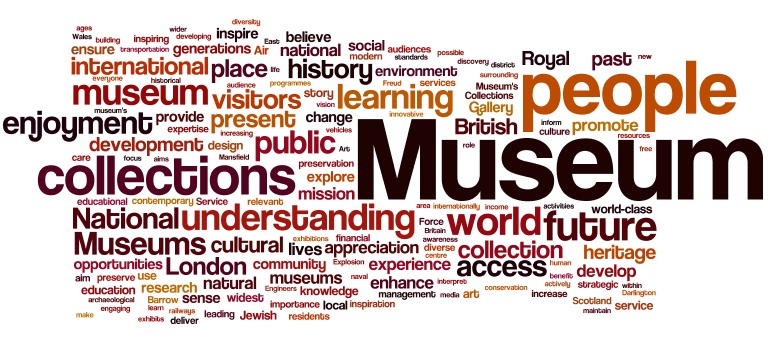What are Museums for? | analysis from the UK

UK Collections Trust CEO Nick Poole explores the role of museums through an analysis of the Mission Statement of 40 leading UK museums and galleries, and finds the results both surprising and encouraging.
You can tell a lot about an organisation from its Mission Statement. A Mission Statement is an assertion of how you see yourself, your role and the impact you want to have on the world. It is designed to inspire and to communicate, serving both as a justification and a clarification of the museums’ aims and objectives. So what can we learn from the Mission Statements of 40 UK museums and galleries, chosen at random?
The visualisation above is a game, not a serious analysis. It does, however, point towards some interesting ideas about what museums see as their primary role. If we disregard the word ‘Museum’, since it is generic to all museums, then the top 10 words (in order) are:
- People (30)
- Collections (22)
- Future (17)
- World (16)
- Understanding (15)
- Learning (14)
- Public (13)
- Enjoyment (13)
- National (12)
- Access (12)
It is hugely reassuring to see ‘People’ and ‘Collections’ first and second respectively. The first duty of museums is to people, society, audiences, users – and this is exactly as it should be. Collections, however, seem to be of equivalent, if slightly lesser importance. Again, yes – Collections lie at the heart of museums, but they exist to serve our social function, not the other way round.
And ‘Future’? How fantastic is it that the word ‘past’ appears in only 8 of the Mission Statements in our sample, but ‘Future’ is the 3rd most common word, appearing twice as often. Heritage helps people understand where they are coming from, so that they can make sense of where they are going. On the basis of this (admittedly cursory) analysis – if someone were to ask you for the ‘elevator pitch’ for museums, you could do a lot worse than ‘People, Collections, Future’!
As someone with a strong interest in the international role of museums, I am heartened to see ‘World’ as a focus of these Mission Statements (the word ‘International’ appears in 10 of them) – speaking as it does of a global outlook, of the way that museums can connect the UK to the world and the world to the UK.
In 5th place, ‘Understanding’ – the fundamental role of museums to help people become culturally literate, to learn to question the world around them and through questioning to come to understand it. Taken together, ‘understanding’ and ‘learning’ speak of a profoundly important self-perception that museums can play a fundamental role in education, both formally and informally.
It is interesting to see ‘Public’ as the 7th most common word in this sample of Mission Statements. This demands further analysis – in some cases it is ‘the Public’ as in ‘we will deliver services for the public’, elsewhere it is ‘public’ in the same sense as ‘Public Realm’ and ‘Digital Public Space’. This could point to an emerging role for museums as civic and public spaces – places in which culture is explored and questioned in a spirit of openness. Equally, it could point to a slightly catch-all ambition to serve the needs of an amorphous ‘general public’.
In 8th place ‘Enjoyment’ – because visiting a museum or gallery should be fun as well as educational and inspirational (‘inspiration’ and its variants, by the way, appear only 6 times…)
I suspect that ‘National’ may be indicative of the bias of the dataset, featuring as it does the Mission Statements of 10 National UK museums!
And finally, just making the top 10 – ‘Access’ – you can decide for yourself whether this represents a strength (in that it appears in the top 10) or a disappointment, appearing only 12 times in 40 Mission Statements!
Visit collectionslink.org.uk to read the full article and download the dataset.
Thanks to ASEMUS Asia-Europe Museum Network for this interesting culture news
Similar content
posted on
31 Dec 2012
15 Apr 2008
posted on
07 Oct 2011
posted on
03 Mar 2012
By Kerrine Goh
25 Jul 2005



